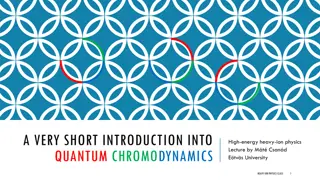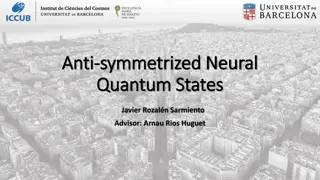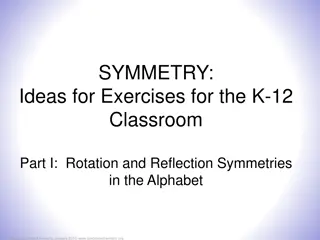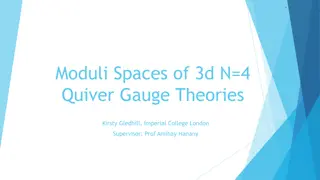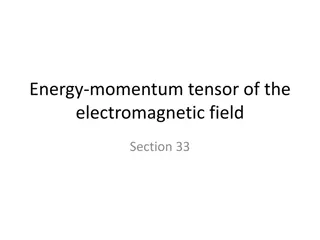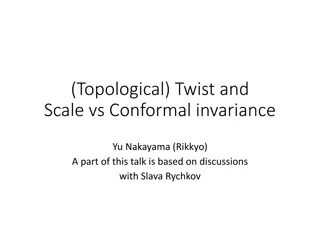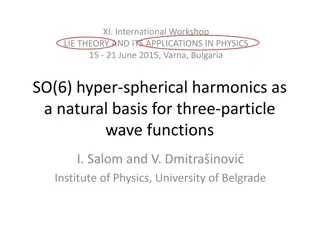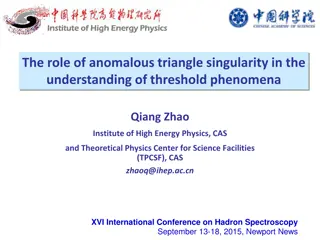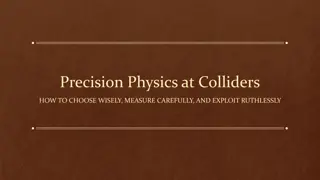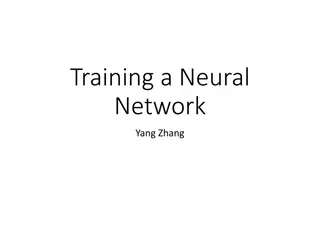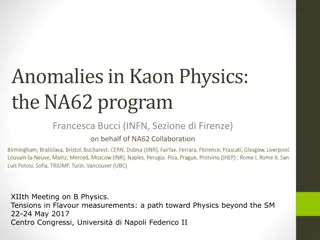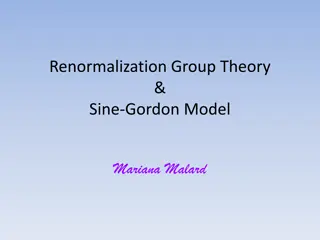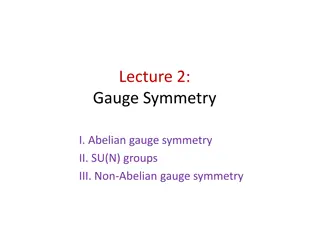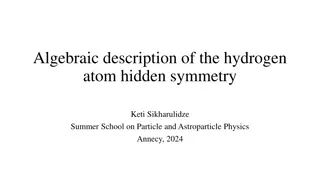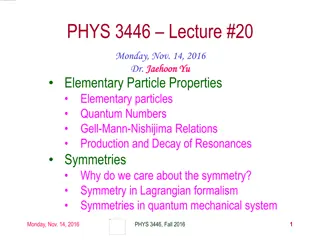Particles and Fundamental Interactions in the Universe
Delve into the intricate world of particles and fundamental interactions in the Universe as explained by Professor Emeritus George Lazarides from Aristotle University of Thessaloniki. Discover the structure of matter, classification of particles based on interactions, constituents of hadrons, conser
2 views • 36 slides
Galois Theory and Field Extensions
Explore the fundamental concepts of Galois theory, field automorphisms, prime subfields, and field extensions. Learn how symmetries and polynomials play a crucial role in creating new mathematical objects, and understand the significance of field extensions in adjoining roots of polynomials. Delve i
1 views • 14 slides
Temperature Independent Paramagnetism (TIP) and Anomalous Magnetic Moments in Metal Ions
Temperature Independent Paramagnetism (TIP) explains the second-order Zeeman effect's magnetic susceptibility unaffected by temperature changes. Anomalous magnetic moments are observed in metal ions, deviating from predicted values based on electron angular momenta. The interaction of spin states in
1 views • 15 slides
Introduction to Quantum Chromodynamics & Field Theories in High-Energy Physics
Explore the fundamentals of Quantum Chromodynamics and Classical Field Theories in this informative lecture, covering topics such as global and local symmetries, Lagrangians, actions, and dynamics. Understand the significance of global and local symmetries in classical field theories, along with exa
5 views • 17 slides
Neural Quantum States and Symmetries in Quantum Mechanics
This article delves into the intricacies of anti-symmetrized neural quantum states and the application of neural networks in solving for the ground-state wave function of atomic nuclei. It discusses the setup using the Rayleigh-Ritz variational principle, neural quantum states (NQSs), variational pa
3 views • 15 slides
Hyper-Spherical Harmonics and Multi-Particle Quantum Systems
Explore the application of hyper-spherical harmonics in solving multi-particle quantum systems, focusing on permutation symmetry and splitting wave functions into radial and angular components. The approach involves using center-of-mass reference systems, Jacobi coordinates for different masses, and
1 views • 21 slides
Nuclear Structure with Machine Learning and Quantum Mechanics
Delve into the world of ab initio nuclear structure through the lens of machine learning and quantum mechanics. Discover the power of neural networks in approximating functions, live neural network training, symmetries in physical properties, and the role of group theory in understanding atomic nucl
0 views • 13 slides
Symmetry in the Alphabet: Rotation and Reflection Symmetries
Discover how rotation and reflection symmetries play a role in the alphabet, with most letters exhibiting some type of symmetry. Explore rotational symmetries both in and perpendicular to the plane, as well as symmetries across horizontal and vertical axes. Learn about the concepts of rotational sym
1 views • 13 slides
Moduli Spaces of 3D N=4 Quiver Gauge Theories
Study the rich moduli spaces and symmetries in 3D N=4 quiver gauge theories, analyzing superpartners, scalar fields, and the natural splitting of moduli space into Coulomb and Higgs branches. Gain insights into SUSY theories, duality, and potential applications in string theory and geometry.
0 views • 8 slides
Quadratic Equations: Graphing, Factoring, and Applications
Explore solving quadratic equations through graphing, factoring, and real-world applications such as finding x-intercepts and determining the roots of a quadratic function. Learn how to interpret zeros, vertices, and symmetries of quadratic functions. Engage with helpful hints, examples, and vocabul
0 views • 49 slides
The Energy-Momentum Tensor of the Electromagnetic Field
Exploring the intricacies of the energy-momentum tensor of the electromagnetic field, including its components, symmetries, and implications on field interactions and invariants. Delve into the mathematical derivations and transformations involved in studying this fundamental concept in electromagne
0 views • 19 slides
Scale vs. Conformal Invariance in Theoretical Physics
Delve into the intriguing concepts of scale invariance and conformal invariance in theoretical physics through discussions on topics such as topological twist, critical phenomena, unitarity arguments, and counterexamples. Explore the fine balance between these two powerful symmetries and their impli
0 views • 19 slides
Interchangeability in Constraint Programming
Explore the concept of interchangeability in constraint programming as proposed by Freuder in 1991. Learn about full interchangeability, neighborhood interchangeability, subproblem interchangeability, and partial interchangeability. Discover how these symmetries can be detected and utilized in solvi
2 views • 16 slides
Overview of Animal Kingdom's Phyla and Characteristics
Animals in the Kingdom Animalia have diverse characteristics and are classified into different phyla based on specific traits and features. This includes Porifera (sponges), Cnidaria (jellyfishes), Platyhelminthes (flatworms), Nematoda (roundworms), Annelida (earthworms), Mollusca (snails, octopus),
1 views • 10 slides
Applications of Hyper-Spherical Harmonics in Physics
Explore the utility of hyper-spherical harmonics as a natural basis for solving three-particle wave functions in physics, specifically in areas such as atomic physics, molecular physics, and systems involving three quarks. Learn about their role in reducing the complexity of problems, providing mani
1 views • 28 slides
Role of Anomalous Triangle Singularity in Threshold Phenomena Understanding
Anomalous Triangle Singularity (ATS) is explored in the context of threshold phenomena understanding, focusing on its occurrence when all three internal particles are simultaneously on shell. The study delves into kinematic effects, genuine states recognition, and specific cases such as heavy pentaq
1 views • 36 slides
Precision Physics at Colliders: Choosing Wisely, Measuring Carefully, and Exploiting Ruthlessly
Precision Physics at Colliders explores the selection, measurement, and utilization of data at colliders, focusing on fundamental symmetries and parameters of the Standard Model. The lectures cover topics such as QCD, top, electroweak, and flavor physics, emphasizing the importance of precision meas
1 views • 42 slides
Trigonometric Graphs and Patterns
Explore trigonometric graphs, key features, and transformations. Learn to calculate sine and cosine values, recognize symmetries, and work with acute angles for solving trigonometric problems. Dive into the world of sine, cosine, and tangent functions with visual aids and practice exercises.
0 views • 15 slides
Neural Network Training and Structure
This text delves into training a neural network, covering concepts such as weight space symmetries, error back-propagation, and ways to improve convergence. It also discusses the layer structures and notation of a neural network, emphasizing the importance of finding optimal sets of weights and offs
0 views • 31 slides
Lucid Dream Experiment: Psychological Balancing Through Dream Symmetries
Explore the Lucid Dream Experiment conducted at the IASD Conference in Anaheim. Discover how basic symmetrical movements in lucid dreams expose imbalances in the psyche and how consciously interacting with dreams can lead to psychological balancing. Dive into dream examples illustrating how dreams r
0 views • 30 slides
Neutrino Mass, Mixing, and Flavor Symmetries
Neutrino physics involves studying mass, mixing, and flavor symmetries, which present new challenges when dealing with multiple neutrinos. The discussion includes neutrino states, mixing matrices, flavor content, vacuum mixing, standard parametrization, mixing angles, global fits, and the Tri-bimaxi
0 views • 59 slides
Conservation Laws: Charge Conjugation, Parity Symmetry, and Violation
In this comprehensive guide, we delve into the intricate concepts of charge conjugation symmetry, G-parity, and the conservation and violation of parity symmetry in fundamental physics. Explore how these principles apply to strong, electromagnetic, and weak interactions through detailed explanations
0 views • 14 slides
Insights into Kaon Physics: Unraveling Anomalies and New Discoveries
Delve into the world of Kaon Physics, from the historical discoveries like CP violation to modern experiments testing fundamental symmetries. Explore anomalies challenging the Standard Model and the implications for new physics models. Discover the interplay of QCD and EW penguin contributions, unce
0 views • 27 slides
Renormalization Group Theory & Sine-Gordon Model
Get insights into Renormalization Group Theory and the Sine-Gordon Model through lectures covering key concepts such as field theory action, decomposition, Green's functions, model scaling, phase diagrams, symmetries, and phase transitions. Discover how scale invariance and order parameters play a r
0 views • 22 slides
Lecture 2: Gauge Symmetry
Delve into the realm of gauge symmetry and SU(N) groups through discussions on Abelian and non-Abelian gauge symmetries, as well as representations of SU(N) groups. Explore the significance of covariant derivatives, massless gauge fields, Lie groups, and various dimensional representations within th
0 views • 13 slides
MO Diagrams for Boron Trifluoride
The content explores MO diagrams for Boron Trifluoride, focusing on point group transformation, reducible reps for outer atoms, and group orbital symmetries. The Projection Operator Method is utilized to determine the shape of group orbitals and how atomic orbitals combine to form the correct group
1 views • 11 slides
Renormalization Group Theory & Sine-Gordon Model
This document provides a detailed exploration of Renormalization Group Theory and the Sine-Gordon Model through a series of lectures. Topics covered include conceptual overviews, procedural steps, phase diagrams, symmetries, scale invariance, and order parameters, with a focus on scale-dependent pro
0 views • 22 slides
Shell Model Study in Nuclear Physics
In this nuclear physics study, the shell model approach was used to explore the A130 region, focusing on shapes, symmetries, and shell evolution in nuclei. Collaborators and experimental insights were also highlighted, along with discussions on proton-neutron interactions, tensor forces, and effecti
0 views • 20 slides
Qualitative Research Guide
Yutaka Utsuno and team's research on shell model study for the A130 region, exploring shapes, symmetries, and nuclear evolution through large-scale shell-model calculations. The study delves into proton-neutron interactions, tensor forces, chiral partner bands, and effective interactions for isotope
0 views • 22 slides
Shell Model Study for A130 Region - Shapes and Symmetries in Nuclei
Study on the shell model in the A130 region focusing on shapes, symmetries, and nuclear structure evolution. Collaboration with researchers from various institutions. Investigating shell evolution, proton-neutron interactions, chiral partner bands, and effective nuclear forces.
0 views • 69 slides
Algebraic Description of Hydrogen Atom Hidden Symmetry and Energy Spectrum Formula
Delve into the fascinating world of the hydrogen atom’s hidden symmetry and the derivation of its energy spectrum formula through solving Schrödinger's differential equation. Uncover the connection between accidental degeneracy and hidden symmetries, brought to light by Pauli. Explore Laplace-Run
0 views • 17 slides
Exploring Genomic Symmetries for Cognitive Development in Humans, Neanderthals, and Chimpanzees
The discovery of the NBPF 3mer HOR genomic symmetries by the Croatian Academy of Sciences and Arts sheds light on the development of cognitive abilities in humans, Neanderthals, and chimpanzees. This interdisciplinary study integrates molecular biology, physics, biochemistry, and bioinformatics, tra
0 views • 27 slides
Tachyon Vacuum in Bosonic OSFT
Explore the tachyon vacuum solution in bosonic open string field theory (OSFT) and its applications in D-brane decay through tachyon condensation. Discover the numerical and analytical solutions, gauge symmetries, and level truncation approaches in the study of string field theory.
0 views • 24 slides
Understanding Elementary Particle Properties and Interactions
Explore the fascinating world of elementary particles, including bosons and fermions, their quantum numbers, interactions, and symmetries. Discover the significance of symmetry in Lagrangian formalism and quantum mechanical systems.
0 views • 13 slides
Particle Physics Conservation Laws and Symmetries Overview
Explore the symmetries and conservation laws in particle physics, such as universal and particular conservation laws including energy, momentum, angular momentum, lepton number, baryon number, and more. Learn about the conservation of angular momentum due to rotational symmetry, and the significance
0 views • 15 slides
Lie Algebras in Physics: Geometric Applications and Non-Compact Groups
Explore the fascinating world of Lie algebras in physics, delving into geometric and non-compact groups, Conservation Laws, Noether's theorem, and the symmetries they reveal. Discover the classification of Lie algebras with Dynkin diagrams, Infinite families, and Exceptional cases. Dive into the com
0 views • 13 slides
Crystal Field Theory and Matrix Elements in Atomic Basis Sets
Explore the concept of crystal field theory expanded on renormalized spherical harmonics by Maurits W. Haverkort at Heidelberg University. Learn about effective Hamiltonians mimicking covalent bonding, matrix elements in the Hamiltonian, and the importance of symmetry in atomic basis sets. Discover
0 views • 8 slides
Algebraic Constructions and Large Vertex Stabilizers in LR Structures
Explore the fascinating concepts of LR structures, tetravalent graphs, cycle decompositions, symmetries, and the properties of LR structures. Learn about the requirements for a suitable LR structure and its relation to the partial line graph in this insightful study.
0 views • 24 slides
Understanding Temperature Independent Paramagnetism (TIP) and Anomalous Magnetic Moments
Explore the concept of Temperature Independent Paramagnetism (TIP) and Anomalous Magnetic Moments in metal ions with unique symmetries. Learn about the magnetic susceptibilities, spin states equilibrium, and the behavior of nickel complexes in different configurations.
0 views • 15 slides



